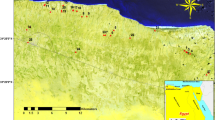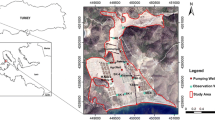Abstract
Several groundwater endorheic base levels are known in different parts of the world. Some of them allow seawater encroachment into them. Two examples of such groundwater systems, at Lake Asal in the Afar Depression of East Africa and Lago Enriquillo in the Dominican Republic, have been modeled using FEFLOW. The simulated flow pattern reproduces the seawater encroachment all the way from the sea to the endorheic base level. When the water in that base level undergoes concentration to brine through evaporation, the dense brine starts to flow below the encroaching seawater body in the opposite direction toward the sea. These processes reach steady-state conditions in a relatively short time of several hundred years.
Résumé
On connaît plusieurs niveaux de base d’aquifères endoréiques dans différentes parties du globe. Quelques uns permettent une invasion marine. Deux systèmes aquifères ainsi pris pour exemples au lac Asal dans la dépression Afar en Afrique de l’Est et à Lago Enriquillo en République Dominicaine ont été modélisés en utilisant FEFLOW. Le modèle d’écoulement utilisé reproduit l’intrusion marine sur toute la distance entre la mer et le niveau de base endoréique. Quand l’eau de ce niveau de base subit une concentration en saumure par évaporation, la saumure dense commence à s’écouler sous la masse d’eau marine invasive en direction opposée vers la mer. Ce processus s’établit en régime permanent dans un temps relativement court de plusieurs centaines d’années.
Resumen
Diversos niveles de base endorreicos de aguas subterráneas se conocen en diferentes partes del mundo. Algunos de ellos permiten la invasión de agua de mar en ellos. Se modelan dos ejemplos de tales sistemas de agua subterránea, en el Lago Asal en la Depresión Afar de África del Este y en el Lago Enriquillo en la República Dominicana usando FEFLOW. El patrón de flujo simulado reproduce la invasión de agua de mar desde el mar hacia el nivel de base endorreico. Cuando el agua en el nivel de base sufre la concentración a salmuera por evaporación, la salmuera densa comienza a fluir por debajo del cuerpo de agua de mar invasora en dirección opuesta hacia el mar. Estos procesos alcanzan condiciones de estado estacionario en un tiempo relativamente corto de varios cientos de años.
Resumo
São conhecidos vários níveis de base de água subterrânea endorreicos em diversas partes do mundo. Alguns deles permitem a entrada de água marinha para dentro deles. Dois exemplos destes sistemas de água subterrânea, o Lago Asal, na Depressão de Afar, África Oriental, e o Lago Enriquillo, na República Dominicana, foram modelados com recurso ao FEFLOW. O padrão de fluxo simulado reproduz todo o caminho de entrada de água a partir do mar para o nível de base endorreico. Quando a água no nível de base atinge a concentração de salmoura através da evaporação, a salmoura densa começa a fluir por baixo da água marinha infiltrada na bacia, deslocando-se na direção oposta, em direção ao mar. Estes processos atingem as condições de estado estacionário no tempo relativamente curto de várias centenas de anos








Similar content being viewed by others
References
Allard P, Tazieff H, Dajlevic D (1979) Observations of seafloor spreading in Afar during the November 1978 fissure eruption. Nature 279:30–33
Ataie-Ashtiani B, Volker RE, Lockington DA (1999) Tidal effects on sea water intrusion in unconfined aquifers. J Hydrol 216:17–31
Audin L, Manighetti I, Tapponnier P, Metivier F, Jacques E, Huchon P (2001) Fault propagation and climatic control of sedimentation on the Ghoubbet Rift Floor: insights from the Tadjouraden cruise in the western Gulf of Aden. Geophys J Int 144:1–28
Ayele A, Nyblade AA, Langston CA, Cara M, Leveque J-J (2006) New evidence for Afro-Arabian plate separation in southern Afar. In: Yirgu G, Ebinger CG, Maguire PKH (Eds) The Afar Volcanic Province within the East African Rift System. Geol Soc Lond Spec Publ 259: 133–141
Bear J, Cheng AH-D, Sorek S, Quazar D, Herrera I (eds) (1999) Seawater intrusion in coastal aquifers: concepts, methods and practices. Kluwer, Dordrecht, The Netherlands
Bobba AG (1993) Mathematical models for saltwater intrusion in coastal aquifers. Water Resour Manag 7:3–37
Bobba AG (2002) Numerical modelling of salt-water intrusion due to human activities and sea-level changes in the Godavari Delta, India. Hydrol Sci J 47:S67–S80
Brewer PG, Spencer DW (1969) A note on the chemical composition of the Red Sea brines. In: Degens ET, Ross DA (eds) Hot brines and recent heavy metal deposits in the Red Sea. Springer, New York, pp 174–179
Buck WR (2006) The role of magma in the development of the Afro-Arabian Rift System. In: Yirgu G, Ebinger CG, Maguire PKH (Eds) The Afar Volcanic Province within the East African Rift System. Geol Soc Lond Spec Publ 259:43–54
Buck DG, Brenner M, Hodell DA, Curtis JH, Martin JB, Pagani M (2005) Physical and chemical properties of hypersaline Lago Enriquillo, Dominican Republic. Verh Int Verein Limnol 29:1–7
Chen BF, Hsu SM (2004) Numerical study of tidal effects on seawater intrusion in confined and unconfined aquifers by time-independent finite-difference method. J Water Port Coastal Ocean Eng 130:191–206
Chiesa S, Mazzoleni G (2001) Dominican Republic (Hispaniola Island, north-eastern Caribbean): a map of morpho-structural units at a scale 1:500,000 through LANDSAT TM image interpretation. Rev Geol Am Cent 25:99–106
Craig H (1969) Geochemistry and origin of the Red Sea brines. In: Degens ET, Ross DA (eds) Hot brines and recent heavy metal deposits in the Red Sea. Springer, New York, pp 208–242
D’Amore F, Giusti D, Abdallah A (1998) Geochemistry of the high-salinity geothermal field of Asal, Republic of Djibouti, Africa. Geothermics 27:197–210
DeMets C, Wiggins-Grandison M (2007) Deformation of Jamaika and motion of the Gonave microplate from GPS and seismic data. Geophys J Int 168:362–378
Diersch H-JG, Kolditz O (2002) Variable-density flow and transport in porous media: approaches and challenges. Adv Water Resour 25:899–944
Doss WC, Greer L, Curran HA, Patterson WP, Mortlock RA (2005) Large tufa-coated serpulid mounds signal and abrupt mid-Holocene transition from marine to restricted hyposaline conditions, Lago Enriquillo, Dominican Republic. Geol Soc Am Abstr with Programs. 37(7):365
Doubre C, Peltzer G (2007) Fluid-controlled faulting process in the Asal Rift, Djibouti, from 8 yr of radar interferometry observations. Geology 35:69–72
Elmi D (2005) Analysis of geothermal well test data from the Asal Rift area, Republic of Djibouti. UN Univ. Geothermal Training Programme Rep. 6, UNU-GTP, Reykjavík, Iceland
Essaid HI (1990) A multilayered sharp interface model of coupled freshwater and saltwater flow in coastal systems: model development and application. Water Resour Res 26:1431–1454
Faure H, Walter RC, Grant DR (2002) The coastal oasis: ice age springs on emerged continental shelves. Glob Planet Chang 33:47–56
Fouillac AM, Fouillac C, Cesbron F, Pillard F, Legendre O (1989) Water–rock interaction between basalt and high-salinity fluids in the Asal Rift, Republic of Djibouti. Chem Geol 76:271–289
Garfunkel Z, Beyth M (2006) Constraints on the structural development of Afar imposed by the kinematics of the major surrounding plates. In: Yirgu G, Ebinger CG, Maguire PKH (eds) The Afar Volcanic Province within the East African Rift System. Geol Soc Lond Spec Publ 259:3–42
Gasse F, Fontes J-C (1989) Palaeoenvironments and palaeohydrology of a tropical closed lake (Lake Asal, Djibouti) since 10,000 year BP. Palaeogeogr Palaeoclimatol Palaeoecol 69:67–102
Gasse F, Rognon P, Street FA (1980) Quaternary history of the Afar and Ethiopian Rift lakes. In: Williams MAJ, Faure H (eds) The Sahara and the Nile: Quaternary environments and prehistoric occupation in northern Africa. Balkema, Rotterdam, The Netherlands, pp 361–400
Ghyben WB (1888) Notes on the probable resultsof well drilling near Amsterdam (in Dutch). Tijdschrift van het Koninklijk Inst. van Ingenieur, The Hague 9:8–22
Harrar WG, Williams AT, Barker JA, Camp MV (2001) Modeling scenarios for the emplacement of palaeowaters on aquifer systems. In: Edmunds WM, Milne CJ (eds) Palaeowaters in coastal Europe: evolution of groundwater since the late Pleistocene. Geol Soc London Spec Publ 189: 213–229
Herzberg B (1901) Die wasserversorgung einiger Nordseebader [The water supply of some North Sea resorts]. J Gasbeleucht Wasservesorg 44(815–819):824–844
Houssein DE, Axelsson G (2010) Geothermal resources in the Asal Region, Republic of Djibouti: an update with emphasis on reservoir engineering studies. Geothermics 39:220–227
Jalludin M, Razack M (1994) Analysis of pumping tests, with regard to tectonics, hydrothermal effects and weathering, for fractured Dalha and stratiform basalts, Republic of Djibouti. J Hydrol 155:237–250
Kafri U (1984) Current subsurface seawater intrusion to base levels below sea level. Environ Geol Water Sci 6:223–227
Kafri U, Arad A (1979) Current subsurface intrusion of Mediterranean seawater: a possible source of groundwater salinity in the Rift Valley System. Israel J Hydrol 44:267–287
Kafri U, Yechieli Y (2010) Groundwater base level changes and adjoining hydrological systems. Springer, Heidelberg
Kafri U, Goldman M, Lyakhovsky V, Scholl C, Helwig S, Tezkan B (2007) The configuration of the fresh–saline groundwater interface within the regional Judea Group carbonate aquifer in northern Israel between the Mediterranean and the Dead Sea base levels as delineated by deep geoelectromagnetic soundings. J Hydrol 344:123–134
Kooi H, Groen J, Leijnse A (2000) Modes of seawater intrusion during transgressions. Water Resour Res 36:3581–3589
Manighetti I, Tapponnier P, Courtillot V, Gallet Y (2001) Strain transfer between disconnected, propagating rifts in Afar. J Geophys Res 106:13613–13665
Mann P, Taylor FW, Burke K, Kulstad R (1984) Subaerially exposed Holocene coral reef, Enriquillo Valley, Dominican Republic. Geol Soc Am Bull 95:1084–1092
Medley PR (2006) Paleohydrology of middle Holocene lagoonal & lacustrine deposits in the Enriquillo Valley, Dominican Republic: pore morphometrics and isotope geochemistry of Ostracoda. Geol Soc Am Abstr with Programs 38:444
Mlynarski M, Zlotnicki J (2001) Fluid circulation in the active emerged Asal rift (east Africa, Djibouti) inferred from self-potential and Telluric-Telluric prospecting. Tectonophysics 339:455–472
Morillo HR, Huertas JFF (2006) Potencial hidrogeologico de la Republica Dominicana [The hydrogeological potential of the Dominican Republic]. Bol Geol Min 117:187–200
Olin M (1995) Estimation of base level from an aquifer from recession rates of groundwater levels. Hydrogeol J 3:40–51
Pizzi A, Coltorti M, Abebe B, Disperati L, Sacchi G, Salvini R, (2006) The Wonji fault belt (Main Ethiopian Rift): structural and geomorphological constraints and GPS monitoring. In: Yirgu G, Ebinger CG, Maguire PKH (Eds) The Afar Volcanic Province within the East African Rift System. Geol Soc Lond Spec Publ 259:191–207
Reilly TR, Goodman AS (1985) Quantitative analysis of saltwater-freshwater relationship in groundwater systems: a historical prespective. J Hydrol 80:125–160
Sanjuan B, Michard G, Michard A (1990) Origine des substances dissoutes dans les eaux des sources thermals et des forages de la region Asal-Ghoubbet (Republique de Djibouti) [The origin of solute substances of the thermal water sources in the wells of the Asal-Ghoubbet region (Republic of Djibouti)]. J Volcanol Geotherm Res 43:333–352
Schoell M, Faber E (1978) New isotopic evidence for the origin of Red Sea brines. Nature 275:436–438
Tarantola A, Ruegg JC, Lepine JP (1980) Geodetic evidence for rifting in Afar, 2: vertical displacements. Earth Planet Sci Lett 48:363–370
Tuttle MP, Prentice CS, Dyer-Williams K, Pena LR, Burr G (2003) Late Holocene liquefaction features in the Dominican Republic: a powerful tool for earthquake hazard assessment in the northeastern Caribbean. Seismol Soc Am Bull 93:27–46
Winsor K, Curran HA, Greer L, Glumac B (2006) Paleoenvironmental implications of mid-Holocene serpulid tube/tufa mounds and underlying coral colonies, Enriquillo Valley, Dominican Republic. Geol Soc Am Abstr with Programs 38:68
Wright TJ, Ebinger C, Biggs J, Ayele A, Yirgu G, Keir D, Stork A (2006) Magma-maintained rift segmentation at continental rupture in the 2005 Afar dyking episode. Nature 442:291–294
Acknowledgements
Thanks are due to Batsheva Cohen from the Geological Survey of Israel who helped with the drafting of the figures. Thanks are also due to associate editor Ward E. Sanford, editor Vincent Post, reviewer Tracy Nishikawa and to anonymous reviewers who contributed to the improvement of the manuscript.
Author information
Authors and Affiliations
Corresponding author
Rights and permissions
About this article
Cite this article
Kafri, U., Shalev, E., Lyakhovsky, V. et al. Numerical modeling of seawater intrusion into endorheic hydrological systems. Hydrogeol J 21, 1001–1010 (2013). https://doi.org/10.1007/s10040-013-0972-5
Received:
Accepted:
Published:
Issue Date:
DOI: https://doi.org/10.1007/s10040-013-0972-5




